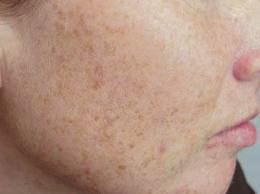IPL devices use a broad band of light from the visible light spectrum to primarily address skin problems such as facial capillaries (eg. rosacea, sun damage) and benign photopigmentation (solar lentigines- freckles, sunspots).
IPL can also be used to in photodynamic therapy for acne.Activating photosensitizers such as methyl aminolevulinate (MAL). IPL treatments are often referred to as ‘photofacials‘ as they are a light-based facial treatment.
A Word About Lasers, Other Light-Based Devices And Safety Issues
IPL devices are being used in non-medical settings such as day spas for the purpose of Laser Hair Removal, or the treatment of “brown spots”. It is very important to be aware that staff at these non-medical facilities do not have medical training in the diagnosis of skin diseases, as well, they do not have the knowledge to distinguish benign from cancerous lesions and are not versed in the area of photosensitizing conditions or medications.
(See: What is Anti- Aging Medicine; Non Medical facilities)
At The Lazer Room, all patients are seen and assessed carefully by a physician prior to their procedure, regardless of whether it is a superficial skin peel, laser hair removal, injectables, IPL or full facial resurfacing. You will be asked to give a full medical history and a list of all current medications, including herbals and nutritional supplements and to disclose any prior procedures, treatment modalities and recent sun, UV or tanning accelerator exposure. In addition, a skin examination will be undertaken to exclude cancer or precancerous lesions.

